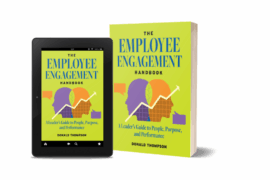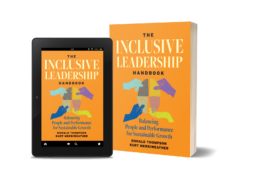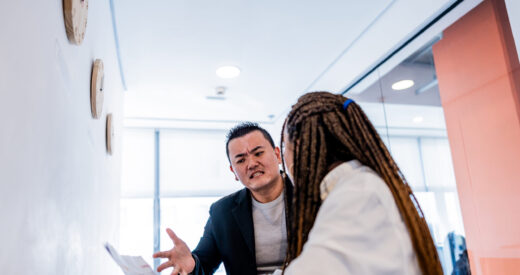Elaine Lin Hering explains how speaking up, despite the risks, can break barriers and unleash talent
In organizations worldwide, psychological safety is one of the strongest predictors of team performance, productivity, and innovation. Yet despite growing awareness of its power, psychological safety at work is still uncommon.
In a 2024 Deloitte survey of U.S. workers, only half said their team leaders foster psychological safety. Those findings echo a study from Southeast Asia, where 45% of employees said their workplaces lacked psychological safety.
Without psychological safety, employees hesitate to speak up, not because they lack courage, but because the perceived risks of doing so—judgment, exclusion, even retaliation—often outweigh the benefits. True psychological safety demands a shift in mindset, culture, and daily interactions.
 Elaine Lin Hering, author of Unlearning Silence: How to Speak Your Mind, Unleash Talent, and Live More Fully, spoke with Jackie Ferguson, host of the acclaimed podcast Diversity: Beyond the Checkbox, about what it takes to build psychological safety in the workplace. A negotiation expert and former Harvard Law School lecturer, Hering has helped people around the world develop the skills to communicate across difference and speak up with confidence.
Elaine Lin Hering, author of Unlearning Silence: How to Speak Your Mind, Unleash Talent, and Live More Fully, spoke with Jackie Ferguson, host of the acclaimed podcast Diversity: Beyond the Checkbox, about what it takes to build psychological safety in the workplace. A negotiation expert and former Harvard Law School lecturer, Hering has helped people around the world develop the skills to communicate across difference and speak up with confidence.
Jackie Ferguson: What inspired you to focus on communication, collaboration, and conflict management?
Elaine Lin Hering: This journey started as one of personal pain. I grew up in a family where we didn’t talk about things. We swept the issues under the rug. Kept the peace on the surface. Everything was fine. Except we all know it’s not.
I went to Harvard Law School intending to be a litigator, but came across a classic negotiation book, “Getting to Yes: Interest-Based Negotiation.” It was this lightbulb moment of, ‘Wait, we can actually talk about things?’ I learned a very expensive lesson in law school: emotions are a thing, and we can talk about them. We could navigate through conflict, and it could actually be productive.
Jackie: You talk about unlearning silence. Where should people start?
Elaine: I start with the mindset that if we are human, then we have needs, goals, hopes, and concerns. It doesn’t make you needy. It doesn’t mean that you’re taking up too much space. It doesn’t mean that you don’t care about other people. It just means that you are human.
But for many people, especially women, there is so much noise. You are supposed to be unflappable, unwavering in your caregiving, and it’s all got to look like an Instagram reel. In those expectations, there is very little room for ‘What do I need. What do I want?’ We spend all this time taking care of everyone else’s needs; we don’t know what our own needs are. Not that they’re not there, but they can get buried under layers of patterns and expectations.
To me, the unlearning part is the excavation. To notice what has become unconscious habit, bring it into the consciousness to wrestle with it, and say, “Is this how I want to live?” If not, we have the opportunity to choose a different way. And a very tactical way is to ask yourself two questions: What do I think? What do I need?
Jackie: And once we know that, how do we communicate it to others?
Elaine: I’d start with experimentation, particularly if you haven’t been used to making those asks, making your needs known. If Jackie has always been go-with-the-flow, saying that you have needs—which makes sense, because you’re human—means other people need to adjust. You can expect some friction.
Jackie: What are the benefits of doing this work—even though it’s uncomfortable?
Elaine: Our brains focus on the discomfort and embedded in that is fear and uncertainty. What our brains don’t do is the second part of the analysis: what are the possible benefits? I might anticipate that other people are going to react negatively, but what if they said, ‘Yes, of course we want to support you. We just didn’t know how. Thank you for giving us something concrete to do.’ Our brains don’t go there.
We also have an opportunity to make it better for everyone else. If we listened to each other—actually considered each other—even if the other person sounds different, says something we never would have thought of, we can lower the risks and the costs for someone else sharing what they really think. That is the power we each have.
There are costs, but there are also benefits. There is the benefit of being seen, known, and heard—even celebrated. There is the benefit of living in alignment with who you are. And then there’s the broader impact of co-creating a world in which each of us gets to thrive. We’re creating that space and creating new norms of being who we actually are versus who we’re expected to be.
Jackie: What prevents people from reaching their full potential at work?
Elaine: I always go back to mindsets, because your mindset drives your actions and behaviors, which drive results.
One pitfall is assuming that you don’t have power. That belief often comes from experience. You said something and it didn’t go well. You spoke up and got shut down, excluded, or penalized. So, you stop. You conclude that your voice doesn’t matter.
As human beings, we focus on the power we don’t have rather than the power we do have. But we each have the ability to profoundly change how other people experience work and life. If we all knew that when we spoke up, someone would hear us, appreciate us, recognize that we took the risk to do it—how much more likely would we be to use our voice?
We can create psychological safety for others based on how we respond. Instead of saying, “Jackie, what the hell are you talking about?” say, “I’ve never thought about that. Thanks for sharing. Can you say more so I can wrap my head around it?” That’s power. That’s culture shaping.
On the flip side, the biggest pitfall I see with leaders is underestimating how hard it is for others to speak up. If you’ve never struggled to have your voice heard, if you’ve always been welcomed in the room, it’s easy to say, “Just speak up.” But not everyone is you. We are not equally situated. We have different experiences, identities, and levels of psychological safety. Leaders must recognize that—and design communication and collaboration in ways that account for difference, not ignore it.
Jackie: What do you hope the future looks like?
Elaine: What I imagine and what I work toward is work environments, communities, and a world in which belonging, dignity, and justice are true for every human being rather than just a select few.
For the complete conversation with Elaine Lin Hering, listen to “Unlearning Silence: Embracing Authenticity and Unleashing Talent in the Workplace” on the Diversity: Beyond the Checkbox podcast. To learn more about psychological safety and how your organization can identify and remove barriers to team cohesion and performance, visit our Psychological Safety Resource Hub.




